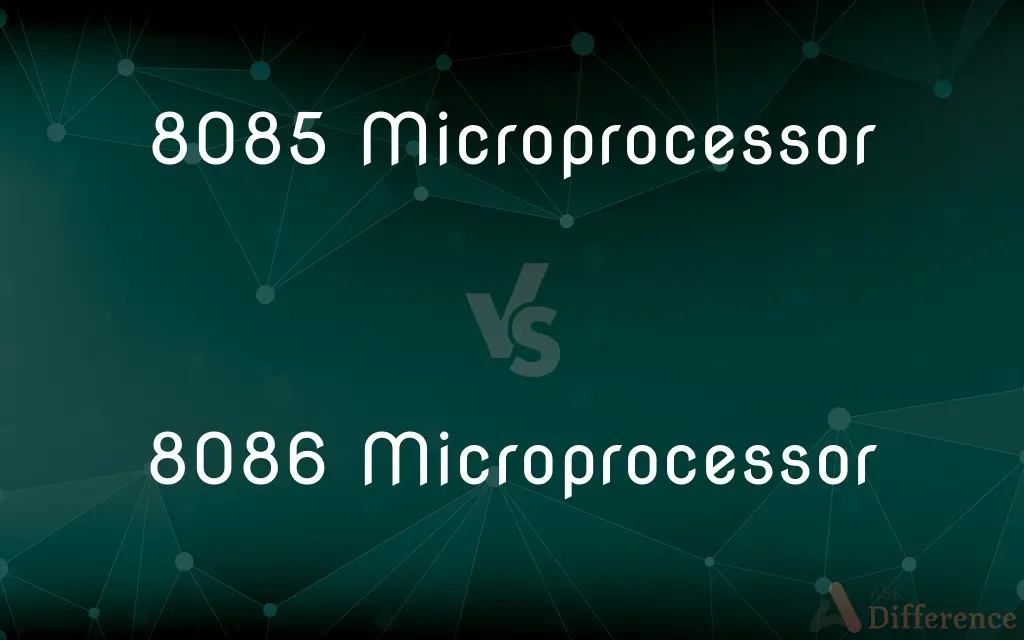8085 Microprocessor vs. 8086 Microprocessor — What's the Difference?
By Tayyaba Rehman — Published on January 28, 2024
The 8085 Microprocessor is an 8-bit processor with a 5 MHz clock speed, primarily for simple tasks, while the 8086 is a 16-bit processor with a 10 MHz clock speed, suited for more complex computing.

Difference Between 8085 Microprocessor and 8086 Microprocessor
Table of Contents
ADVERTISEMENT
Key Differences
The 8085 Microprocessor, introduced by Intel in 1976, operates on an 8-bit architecture, making it suitable for basic computational tasks. In contrast, the 8086 Microprocessor, released in 1978, is a 16-bit processor, providing enhanced computing capabilities and efficiency for more complex operations.
Clock speed is a key differentiator; the 8085 operates at a clock speed of up to 5 MHz, which influences its processing speed. The 8086, on the other hand, boasts a higher clock speed of up to 10 MHz, allowing for faster data processing and execution of instructions.
In terms of memory addressing, the 8085 can address up to 64KB of memory, fitting for its time but limited by today's standards. The 8086 surpasses this with a capacity to address up to 1MB of memory, reflecting its more advanced design for handling larger data sets.
The instruction set of the 8085 is simpler, reflecting its focus on basic tasks. The 8086, however, has a more complex instruction set, supporting a broader range of operations and applications, including the ability to handle multitasking more effectively.
Connectivity and interfacing also differ; the 8085 supports serial communication, aligning with its simpler design. The 8086 offers more advanced interfacing capabilities, including support for both serial and parallel communication, enhancing its versatility in different computing environments.
ADVERTISEMENT
Comparison Chart
Architecture
8-bit processor
16-bit processor
Clock Speed
Up to 5 MHz
Up to 10 MHz
Memory Addressing
Up to 64KB
Up to 1MB
Instruction Set
Simpler, for basic tasks
More complex, for varied operations
Communication Interface
Primarily serial
Supports both serial and parallel
Compare with Definitions
8085 Microprocessor
A processor with a maximum clock speed of 5 MHz.
We utilized the 8085 microprocessor for its compatibility with low-speed operations.
8086 Microprocessor
An Intel microprocessor with a clock speed of up to 10 MHz.
We upgraded to the 8086 microprocessor for faster operational efficiency.
8085 Microprocessor
Intel's innovation for entry-level computing tasks.
The 8085 microprocessor revolutionized entry-level computing in the late 70s.
8086 Microprocessor
A versatile microprocessor supporting both serial and parallel communication.
The 8086 microprocessor's parallel communication capability enhanced our device's performance.
8085 Microprocessor
A microprocessor with simple interfacing for basic devices.
Our basic calculator design incorporates the 8085 microprocessor.
8086 Microprocessor
A processor capable of addressing up to 1MB of memory.
With the 8086 microprocessor, we could handle larger data sets effectively.
8085 Microprocessor
An 8-bit microprocessor used in early computing systems.
The 8085 microprocessor was fundamental in my first computer project.
8086 Microprocessor
A 16-bit processor known for its advanced computing capability.
The 8086 microprocessor was a game changer for complex data processing.
8085 Microprocessor
A basic microprocessor for learning and simple applications.
Students often start learning microprocessor basics with the 8085 model.
8086 Microprocessor
A foundational processor in the development of early personal computers.
Early personal computers often featured the 8086 microprocessor.
Common Curiosities
What is the basic architecture of the 8085 microprocessor?
It's an 8-bit microprocessor designed for simple computational tasks.
What kind of memory can the 8086 microprocessor address?
It can address up to 1MB of memory, allowing for more complex operations.
What's the clock speed of the 8085 microprocessor?
It has a maximum clock speed of 5 MHz.
Did the 8086 microprocessor lead to any significant computing advancements?
Yes, it played a pivotal role in the development of early personal computers.
What was the release year of the 8086 microprocessor?
The 8086 was introduced by Intel in 1978.
What are the key features of the 8086 microprocessor?
The 8086 is a 16-bit microprocessor with a higher clock speed and advanced computing capabilities.
Are there any modern equivalents to the 8086 microprocessor?
Modern processors are far more advanced, but the 8086 laid the groundwork for subsequent designs.
What kind of devices used the 8085 microprocessor?
It was used in early computing devices, educational systems, and simple electronic products.
Is learning the 8085 microprocessor useful for understanding modern processors?
Yes, it provides fundamental knowledge useful for understanding the basics of microprocessor technology.
Is the 8085 microprocessor still used today?
It's mostly used for educational purposes and in some simple legacy systems.
Can the 8085 microprocessor handle complex computing tasks?
It's more suited for basic tasks due to its 8-bit architecture and lower clock speed.
What is the significance of the 8085 and 8086 microprocessors in computing history?
They were pivotal in the evolution of microprocessors, marking the transition from basic to more advanced personal computing.
Can the 8086 microprocessor support multitasking?
Its advanced architecture and higher memory capacity make it more suitable for multitasking compared to the 8085.
How does the instruction set of the 8085 compare to the 8086?
The 8085 has a simpler instruction set, while the 8086's is more complex and versatile.
Are there any specific applications where the 8086 excels over the 8085?
Yes, the 8086 is better suited for applications requiring more processing power and memory, such as early personal computers.
Share Your Discovery

Previous Comparison
IndiGo vs. Air India
Next Comparison
Active Filter vs. Passive FilterAuthor Spotlight
Written by
Tayyaba RehmanTayyaba Rehman is a distinguished writer, currently serving as a primary contributor to askdifference.com. As a researcher in semantics and etymology, Tayyaba's passion for the complexity of languages and their distinctions has found a perfect home on the platform. Tayyaba delves into the intricacies of language, distinguishing between commonly confused words and phrases, thereby providing clarity for readers worldwide.
















































